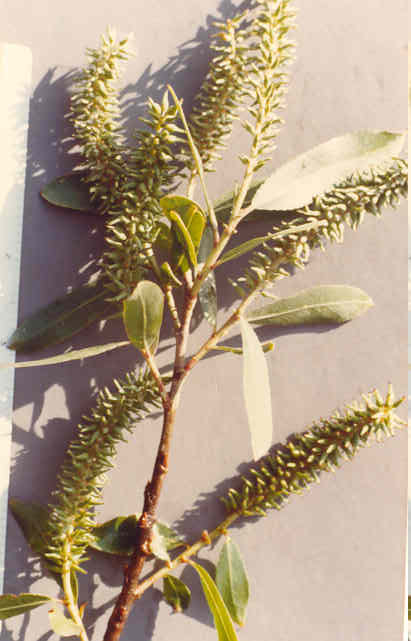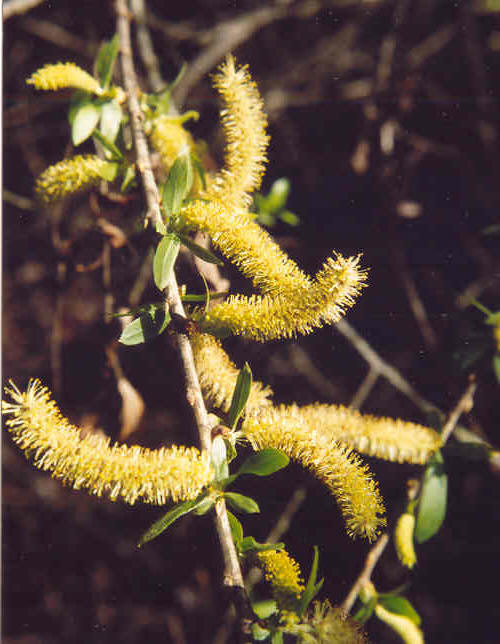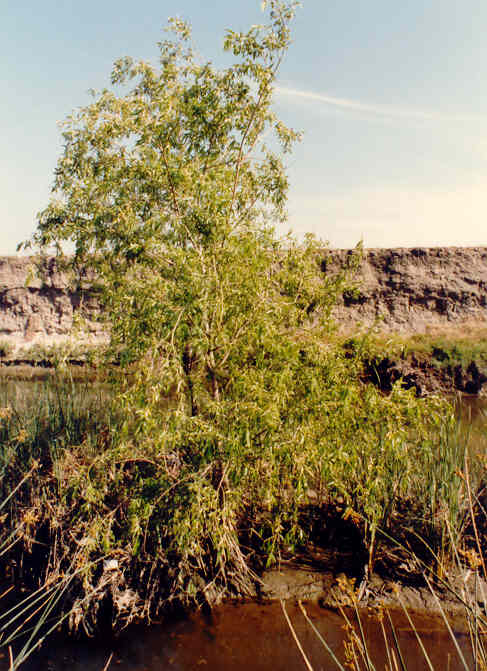
Salix gooddingii C. Ball
=Salix gooddingii var. gooddingii
=S. nigra var. vallicola
 |
Salix gooddingii C. Ball=Salix gooddingii var. gooddingii=S. nigra var. vallicola
Salicaceae (Willow Family)NativeGoodding's WillowBlack Willow |
March Photo
Plant Characteristics:
Tree 6-10 (-20) m. tall with rough dark bark, sometimes shrubby; twigs
yellowish; lvs. narrowly lanceolate, acute or acuminate, finely
glandular-serrulate, grayish-green, 6-10 cm. long, 0.6-1.5 cm. wide; often
pubescent when young; petioles 6-10 mm. long; stipules usually +/- glandular;
catkins 4-8 cm. long, on lateral leafy branchlets 2-4 cm. long; stamens 4-5,
pubescent; subtended by yellow bracts; caps. 5.5-7 mm. long, pilose; pedicels
2-3 mm. long; styles and stigmas very short.
Habitat:
Stream banks and wet places, mostly below 2000 ft.; cismontane s. Calif.;
Coastal Sage Scrub, etc. Bloom date
not given in Munz.
Name:
Salix, the classical name of willow. (Bailey 318).
Gooddingii, named for Leslie Newton Goodding, 1880-.
(Bailey 44).
General:
Occasional in the study area.
Photographed in the area where the old Salt Works stood.
(my comments).
A tea made from the bark was used for lumbago.
A near white dye was made from the stems and used in basketry.
Salix spp. was used for bows in s. Calif.
Salix spp. were probably the most widely used basket materials because of
their strength and resiliency. Peeled
willow stems were used for both warps (foundations) and wefts (wrappings), and
often for hoops or rim bindings. (Heizer
and Elsasser 132,136,141).
The bitter taste of salicin in black willow, Salix nigra, was said
to cure fever at times as well as tanning leather. (Fielder 182, 219).
When Mary Thomas gets a headache, she has thousands of pain relievers
from which to choose. Ms. Thomas, a technical specialist for Dow Chemical Co.,
collects aspirin, in all forms, from all over the globe....In all, it's
estimated that each year chemical companies produce enough acetysalicylic acid,
or aspirin, to make about 90 billion tablets....Aspirin, the Model T of
over-the-counter drugs, was thrust back into the spotlight recently when the New
England Journal of Medicine reported a study showing its effectiveness in
preventing heart attacks among healthy men.
That study is the latest chapter in the history of one of the oldest and
most widely used medications in the world.....The Aspirin Foundation, an
industry group, boasts that the drug "probably has been taken, at one time
or another, by almost every human being on earth."....Hippocrates
recommended in about 400 B.C. that women chew willow bark, an early form of
aspirin, to relieve labor pains. Native
Americans also used the bark for centuries. (For the naturalists, or the hardy,
of today, some health-food stores sell ground-up willow bark to be used a pain
reliever.) In the mid-18th century,
one medical theory held that nature often put a cure where a disease was found.
In 1763, the Rev. Edward Stone noticed that willow trees grew in almost
the same moist areas where swamp fever, a malady marked by chills and high
fever, occurred. He reported to the
Royal Society in England that he "accidentally" tried chewing the bark, and it helped. Naturally
occurring forms of aspirin were isolated in the 1800's but were still tough to
swallow; users of the time compared them to having fire ants in the stomach.
Decades later, Felix Hoffman, seeing the trouble his arthritic father had
in digesting the stuff, tested a variety of chemical derivatives, using his dad
as a guinea pig. Mr. Hoffman worked
at Germany's Bayer AG, which began marketing his more palatable mixture in 1899.
Shortly afterward, Bayer brought aspirin to the U.S....Aspirin does three
main things: It eases pain (comfort to the 3.5 million Americans who get
headaches each week); it relieves inflammation, especially helpful for people
with arthritis; and it reduces fever. ...Put
some in your Christmas tree stand, and the tree will last longer. (They reduce
the rate at which the leaves lose moisture to the air.)
Put one in a vase and your flowers will last longer.
If you take too many your ears will ring.
(No one seems to know why.) If
they get too old, aspirin tablets smell like vinegar and grow little hairs.
And there apparently is no truth to the myth, which has surfaced
periodically since the 1920's, that if you crush an aspirin and mix it with
coke, you'll feel drunk. (Dolan,
Carrie. "What Soothes Aches, Makes Flowers Last, and Grows
Hairs?" The Wall Street
Journal. February 19, 1988. pp. 1,16).
The bark is a botanical source of magnesium and sodium. (Meyer 163).
Exerts a good influence on the sex organs, as in cases of incontinence,
excessive sexual desire, and acute gonorrhea.
Combined with palmetto berries or scullcap is good for nocturnal
emissions. (Kloss 188). The Yuma Indians of southeastern California
ate the bark from seedlings of S. gooddingii.
All of the lower Colorado
Indian tribes made a drink from willow flowers. (Campbell 141). Many tribes made bows of Salix
gooddingii. Bows were generally
about 52 inches long and about 5 inches from bowstring to bow at the grip. The center of the bow was about 1.25 inches wide, a little
less in depth. Nearly circular in
cross section, the grip, or center of the bow extended about 10 inches in a
slight reflex. It began to thin on
the inside toward the arms, which were flat with rounded edges and went from
about .625 inches to .50 inches at the end.
The back of the bow was curved and the inside was flat. (Campbell 269).
See Salix discolor, S. exigua. and S. lasiolepis for
additional uses of the willow. (my
comment).
Text Ref:
Hickman, Ed. 997; Munz, Calif. Flora 913; Munz, Flora So. Calif.
774; Roberts 37.
Photo Ref:
April 2 83 # 16A,17A; July 1 83 # 3; April 2 84 # 6,7; May 1 84 # 14; May
2 88 # 5,6,7
Identity: by R. De Ruff, confirmed by F. Roberts.
First Found: April 1983.
Computer Ref: Plant Data 271.
Have plant specimen.
Last edit 10/15/04.
 |
 |
April Photo May Photo